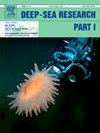Unique gastropods dominate the fauna on inactive vent sulfide features in the eastern Pacific
IF 2.1
3区 地球科学
Q2 OCEANOGRAPHY
Deep-Sea Research Part I-Oceanographic Research Papers
Pub Date : 2025-03-04
DOI:10.1016/j.dsr.2025.104475
引用次数: 0
Abstract
Understanding the extent of habitat adaptation and endemism is essential for assessing resilience to natural and human disturbances. In the deep sea, a habitat of heightened interest is inactive vent sulfide features that form when hydrothermal vent activity ceases, changing the physical and chemical environment and shifting the microbial and animal community. Limited prior sampling of macrofauna (<1 cm) living on these features has suggested that some invertebrate species may be endemic and uniquely adapted to inactive sulfides. Here, we characterize the macrofaunal community composition across different sulfide rock surface types from two inactive sulfide features near the 9°47–50′N vent field of the East Pacific Rise (EPR). Using macrofauna identification, and image analysis of faunal density, we found a dense macrofaunal community dominated by gastropods. Most of the gastropod species appear uniquely associated with inactive sulfide features on the EPR. Further, the composition, diversity, and density of gastropods varied with rock surface characteristics, suggesting a trophic web driven by rock-based microbial chemosynthesis. As metal-rich inactive sulfide deposits are a target for seafloor mining, this discovery of a unique community highlights the need to better understand this type of fauna and its contribution to functional and taxonomic biodiversity in the world's oceans.
独特的腹足类动物在东太平洋不活跃的硫化物喷口特征上占主导地位
了解生境适应和地方性的程度对于评估对自然和人类干扰的恢复能力至关重要。在深海,当热液喷口活动停止时形成的不活跃的喷口硫化物特征引起了人们的高度兴趣,这些特征改变了物理和化学环境,并改变了微生物和动物群落。先前对生活在这些地物上的大型动物(1厘米)的有限采样表明,一些无脊椎动物可能是特有的,并且独特地适应了非活性硫化物。本文利用东太平洋凸起(EPR) 9°47 - 50′n喷口附近两个非活动硫化物特征,对不同硫化物岩石表面类型的大型动物群落组成进行了表征。通过大型动物鉴定和动物密度图像分析,发现该区以腹足类动物为主的大型动物群落。大多数腹足类动物在EPR上表现出独特的非活性硫化物特征。此外,腹足类动物的组成、多样性和密度随岩石表面特征而变化,表明岩石微生物化学合成驱动了营养网。由于富含金属的非活动硫化物矿床是海底采矿的目标,这一独特群落的发现凸显了更好地了解这类动物群及其对世界海洋功能和分类生物多样性的贡献的必要性。
本文章由计算机程序翻译,如有差异,请以英文原文为准。
求助全文
约1分钟内获得全文
求助全文
来源期刊
CiteScore
4.60
自引率
4.20%
发文量
144
审稿时长
18.3 weeks
期刊介绍:
Deep-Sea Research Part I: Oceanographic Research Papers is devoted to the publication of the results of original scientific research, including theoretical work of evident oceanographic applicability; and the solution of instrumental or methodological problems with evidence of successful use. The journal is distinguished by its interdisciplinary nature and its breadth, covering the geological, physical, chemical and biological aspects of the ocean and its boundaries with the sea floor and the atmosphere. In addition to regular "Research Papers" and "Instruments and Methods" papers, briefer communications may be published as "Notes". Supplemental matter, such as extensive data tables or graphs and multimedia content, may be published as electronic appendices.

 求助内容:
求助内容: 应助结果提醒方式:
应助结果提醒方式:


